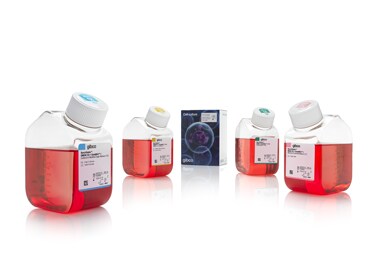Gibco™ BenchStable™ Cell Culture Media: Go Green by Reducing Laboratory Cold Storage Needs
Advances in science and technology are critical to the continued evolution of society, including medical, environmental, and industrial breakthroughs. However, scientific research and development have also led to an increase in pollution and global warming. According to National Oceanic and Atmospheric Administration (NOAA) scientists, the year 2023 is likely to rank among the ten warmest years on record, with high temperatures and other adverse changes to climate likely due to carbon dioxide and other greenhouse gas emissions.1,2 Cold storage is a known substantial contributor to greenhouse gas emissions, with approximately 25% of laboratory energy consumption coming from cold storage.3
As an answer to this issue, and in accordance with their commitment to making the world healthier, cleaner, and safer, Thermo Fisher Scientific’s breakthrough Gibco™ BenchStable™ Media allows cell culture laboratories to store media at room temperature, reducing their cold storage footprint and decreasing negative environmental impacts. Based on calculations using energy consumption by Thermo Scientific™ TSX Series high-performance refrigerators, the global replacement of conventional media with BenchStable™ Media could result in a reduction in greenhouse gas emissions equivalent to removing over 5,000 passenger vehicles from the road each year.
Gibco™ BenchStable™ Media are available in the most commonly used formulations (DMEM, DMEM/F-12, RPMI 1640, and MEM) and have been proven to support cell culture performance at levels equivalent to standard cell culture media. BenchStable™ Media can be stored at room temperature prior to FBS supplementation for up to one year from the date of manufacture. This shelf life matches that of standard basal media under cold storage, with necessary vitamin and amino acid levels maintained over time in BenchStable™ media (Figure 1).
Furthermore, BenchStable™ Media bottles are provided in a recyclable, light-blocking paperboard box to protect media from the harmful effects of light exposure. Compared to the contributions of cold storage facilities on greenhouse gas emissions, this additional packaging has minimal environmental impacts.

Comparable Growth and Functional Maintenance
The long-term effect of BenchStable™ Media on cell growth was assessed by comparing morphology and growth rates of cells cultured in 10% FBS-supplemented BenchStable™ medium to cells grown in a traditional medium. No significant performance or morphological differences were observed.
Results showed that doubling times for four cell types (adherent HeLa, adherent HEK293, adherent SH-SY5Y, and suspension Jurkat cells) were equivalent in BenchStable™ Media and traditional media types (Figure 2). SH-SY5Y, HEK293, and HeLa cells cultured in BenchStable™ Media were visually indistinguishable from those grown in standard media. Complex biological functions were also preserved in cells cultured in BenchStable™ Media, including the maintenance of expected gene expression patterns and healthy mitochondria (Figure 3).
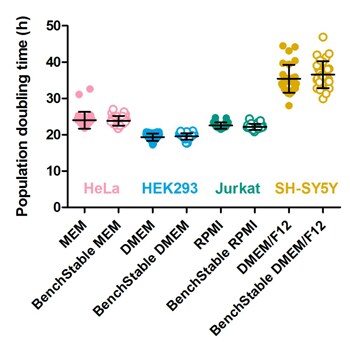
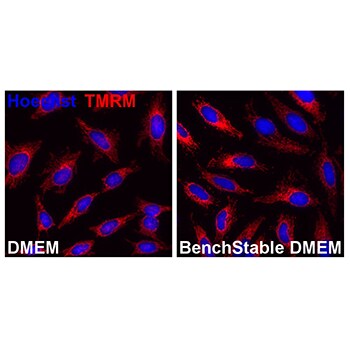
Equivalent Downstream Assay Performance
BenchStable™ Media were also shown to support cellular performance in downstream experiments and assays, including transfection and differentiation experiments. HeLa cells grown in BenchStable™ MEM exhibited transfection efficiencies equivalent to cells grown in standard MEM (Figure 4).
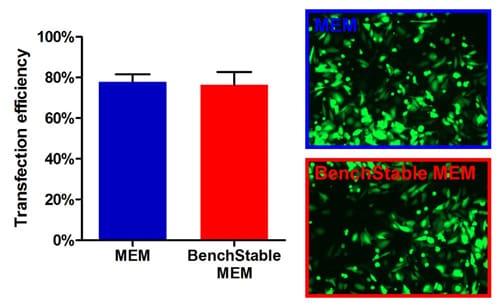
SH-SY5Y neuroblastoma cells cultured in standard and BenchStable™ DMEM/F-12 were assessed for their differentiation potential. Fluorescence microscopy data indicated that cells cultured in both media types exhibited good differentiation capabilities, confirming that BenchStable™ Media are compatible with complex and prolonged downstream assays (Figure 5).
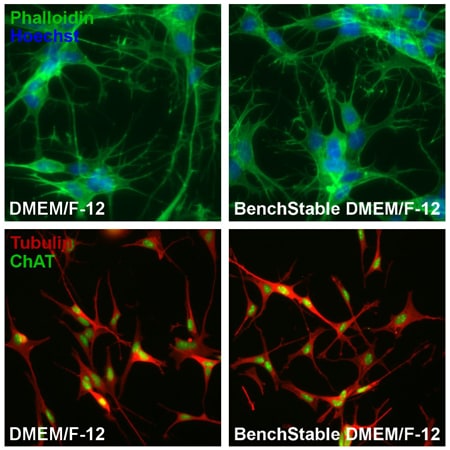
An Eco-Friendly Cell Culture Solution
By enabling storage at room temperature prior to FBS supplementation and with performance equivalent to that of standard cell culture media, Gibco™ BenchStable™ media represent a greener option for cell culture laboratories.
References
1 Assessing the Global Climate in January 2023. www.ncei.noaa.gov/news/global-climate-202301
2 Annual 2019 Global Climate Report. National Centers for Environmental Information (National Oceanic and Atmospheric Administration). www.ncei.noaa.gov/access/monitoring/monthly-report/global/201913. Accessed: June 8, 2020.
3 Paradise A. Market Assessment of Energy Efficiency Opportunities in Laboratories. Center for Energy Efficient Laboratories. ET Project Number: ET14PGE7591, ET15SCE1070, ET14SDG1111. Issued March 12, 2015. www.etcc-ca.com/sites/default/files/reports/ceel_market_assessment_et14pge7591.pdf. Accessed June 8, 2020.
